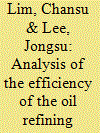| Srl | Item |
| 1 |
ID:
176796


|
|
|
|
|
| Summary/Abstract |
This study investigated the efficiency of the oil refining industry using the two-stage method of Markowitz portfolio optimization theory and panel data analysis of about 30 OECD countries from 2005 to 2016, which is a new methodology for measuring the efficiency of the oil industry. The oil refining industry's efficiency is derived from the prices of petroleum products (Naphtha, Gasoline, Kerosene, Diesel, and Fuel Oil) using the portfolio theory. The panel data was constructed using the following dependent variables, the crude oil production efficiency, energy consumption, renewable energy consumption, and R&D investment. Using the panel data analysis, empirical analyzes are conducted on how the efficiency of the oil refining industry is affected by explanatory variables. The results show that crude oil production and energy use in OECD countries have a negative effect on the efficiency of the oil refining industry, and consumption of renewable energy and R&D investment have a positive effect. Contrary to conventional perception, the petroleum industry can coexist with the renewable energy industry for sustainable development.
|
|
|
|
|
|
|
|
|
|
|
|
|
|
|
|
| 2 |
ID:
092750


|
|
|
|
|
| Publication |
2009.
|
| Summary/Abstract |
This article presents a model for investing in renewable energies in the framework of the Spanish electricity market in a way that risk is minimised for the investor while returns are maximised. The model outlined here is based on an economic model for calculating cash flows intended to obtain the internal rate of return (IRR) of the different energies being studied: wind, photovoltaic, mini hydro and thermo electrical. The IRRs obtained are considered the returns on investments, while their standard deviations are considered associated risks. In order to minimise risk, a comprehensive portfolio of investments is created that includes all of the available energies by means of a system of linear equations. The solution of the linear system is graphically checked using the efficient frontier method for the different financing options. Several case studies within the Renewable Energies Plan (PER is its Spanish abbreviation) that is in force in Spain in the period 2005-2010 are analysed in order to illustrate the method, as are other case studies using different types of financing, helping us to reach the pertinent conclusions.
|
|
|
|
|
|
|
|
|
|
|
|
|
|
|
|